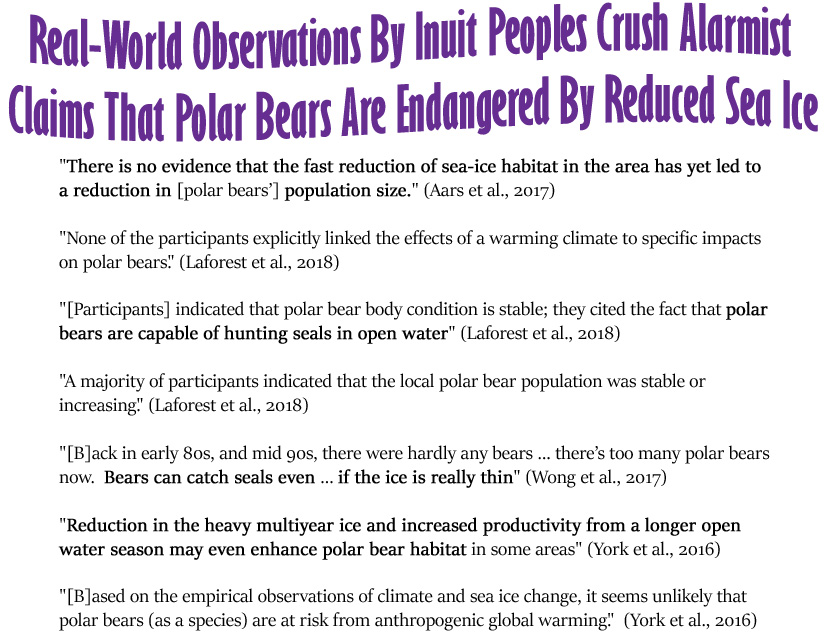By Kenneth Richard on 12. March 2018
A remarkably unsophisticated paper was published a few months ago curiously entitled Internet Blogs, Polar Bears, and Climate-Change Denial by Proxy. Among the list of co-authors of Harvey et al. (2017) are two rather familiar names in climate science circles: Michael E. Mann and Stephan Lewandowsky.
The 14 authors liberally utilize name-calling and broad-brushed accusation (i.e., “unsubstantiated opinions of climate-change deniers”) to make the claim that “climate-change deniers” have no scientific backing for their “opinions”, and so they consequently use the same scare-mongering rhetorical devices and tactics as creationism apologists to advance their cause.
“Proponents of creationism and intelligent design use the same strategy [as climate-change deniers]: Instead of providing scientific evidence in favor of their opinions, they instead focus selectively on certain lines of evidence for evolution and attempt to cast doubt on them (Nisbet 2009).”
“Rhetorical devices to evoke fear and other emotions, such as implying that the public is under threat from deceitful scientists, are common tactics employed by science-denier groups (Barry et al. 2008).”
The purpose of their paper is to make the case that widely-read “denier blogs” like Watts Up With That and Climate Depot have cherry-picked an anthropogenic global warming (AGW) icon, the polar bear, and then proceeded to hand-wave by denying the “well established” science that says these bears’ survival and ability to obtain food (i.e., hunt seal) is threatened by reductions in sea ice. In denying that these animals are endangered by sea ice losses, the polar bear has become a “proxy” or “keystone domino” for denying all the other dire consequences associated with AGW.
“Here, focusing on Arctic sea ice and polar bears, we show that blogs that deny or downplay AGW disregard the overwhelming scientific evidence of Arctic sea-ice loss and polar bear vulnerability. By denying the impacts of AGW on polar bears, bloggers aim to cast doubt on other established ecological consequences of AGW.”
Indeed, Harvey et al. (2017) authors claim that the evidence is both “overwhelming” and “well established” that polar bears can only hunt and catch their main prey, seals, “from the surface of the sea ice”. They can not catch seals in the open water. Consequently, as long as there is less sea ice available, “AGW assures that all polar bears ultimately will be negatively affected.”
Inuit Observations, And Scientists Who Record Them, Are Now ‘Climate-Change Denial’
The native Inuit peoples who have lived in the Arctic and observed polar bear hunting practices for generations are apparently deserving of the “climate-change denier” moniker.
For that matter, the audacious scientists who risk the ire of the AGW gatekeepers to interview these community leaders and then publish their results in scientific journals apparently must be classified as “climate-change deniers” too.
Why? Because there appears to be widespread agreement among Inuit observers that polar bears are skilled swimmers who can catch seals in open water (and not just from sea ice surfaces). This observation wholly contradicts the “well established” and “overwhelming” scientific evidence identified in Harvey et al. (2017) that says polar bears can only catch seals from a sea ice platform.
“The [native populations’] view of polar bears as effective open-water hunters is not consistent with the Western scientific understanding that bears rely on the sea ice platform for catching prey (Stirling and McEwan, 1975; Smith, 1980). The implications of this disagreement are paramount, given that scientists suggest that the greatest threat to polar bears associated with a decrease in sea ice is a significant decrease in access to marine mammal prey (Stirling and Derocher, 1993; Derocher et al., 2004).” — Laforest et al., 2018
‘There’s Too Many Polar Bears Now’
Not only do the generational observations indicate that polar bears’ hunting practices are not duly harmed by sea ice reduction, but community participants consistently report thriving and growing polar bear populations — especially in recent years.
An extensive analysis by York et al. (2016), relying heavily on native reports, concluded that 12 of 13 Canadian Arctic sub-populations have been stable or growing in recent decades. Wong et al. (2017) recorded Inuit community members reporting “there’s too many polar bears now.”
Even aerial analysis has revealed stable to growing polar bear populations across wide swaths of the Arctic. Aars et al. (2017), for example, report that there is “no evidence” that reduced sea ice has led to a reduction in polar bear population size. To the contrary, these scientists found that polar bears living near the Barents Sea increased in number by 42% — from 685 to 973 — between 2004 and 2015.
Unconvincing Claims Of ‘Overwhelming Scientific Evidence’
The fact that the real-world observations of seal-hunting in open water can be collaborated by stable to growing population sizes would appear to support the Inuit version of polar bear science and to simultaneously undermine the Harvey et al. (2017) version of polar bear science.
If Michael E. Mann, Stephan Lewandowsky, and the other authors of the Harvey et al. (2017) polemic wish to characterize those who reject observational evidence (i.e., science) as “deniers”, perhaps they should first get their own “facts” straight.
As a requisite, Mann and his colleagues should seek to persuade Inuit community members that they have not actually witnessed polar bears hunt seals in open waters, or that they have not actually observed an increase in polar bear population size in recent decades.
After this insidious “denialism” permeating Inuit communities has been eradicated, the 14 authors of Harvey et al. (2017) might then have a leg to stand on in going after the “denier blogs” and their creationist-style tactics and scare-mongering rhetorical devices.



